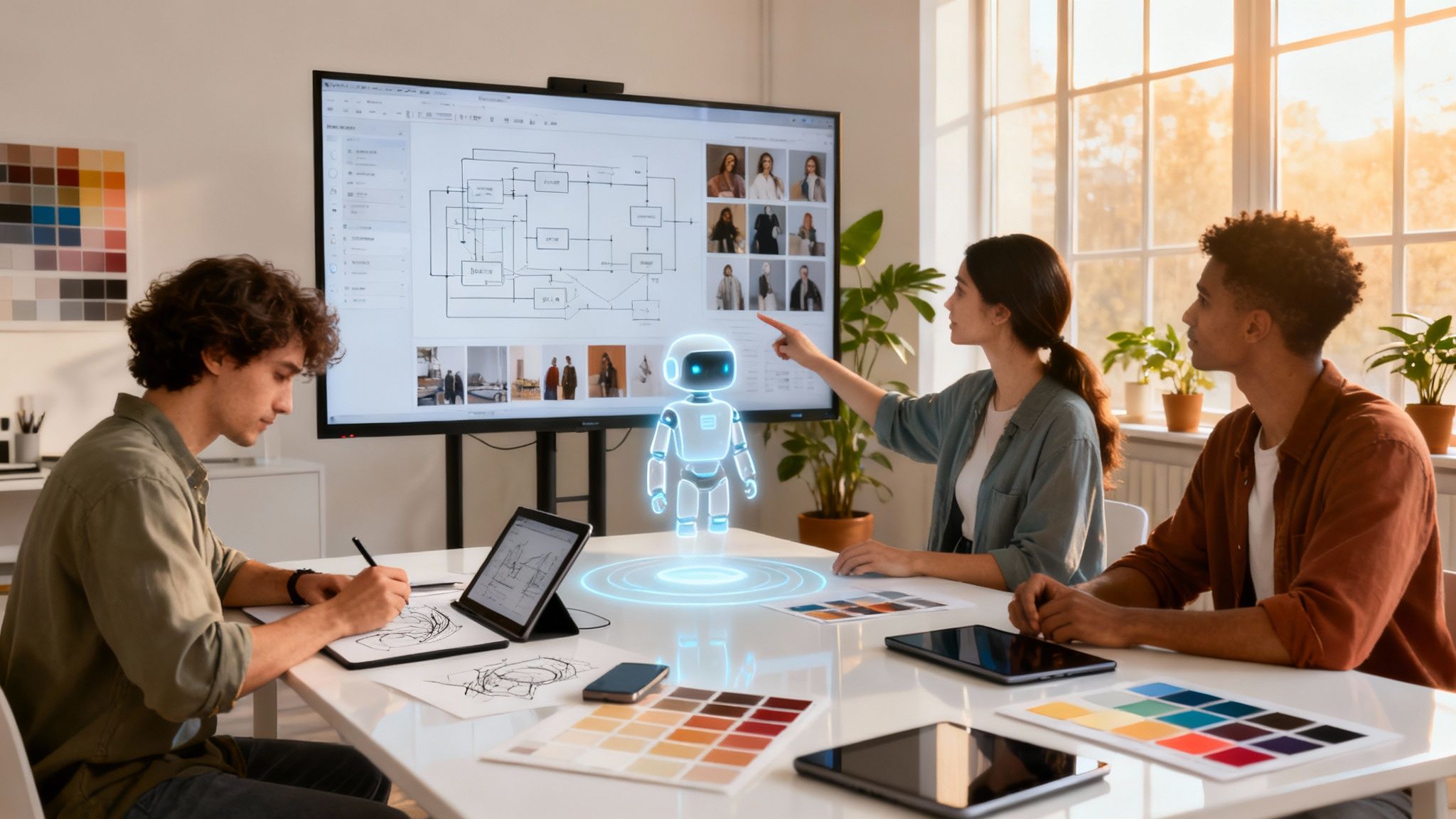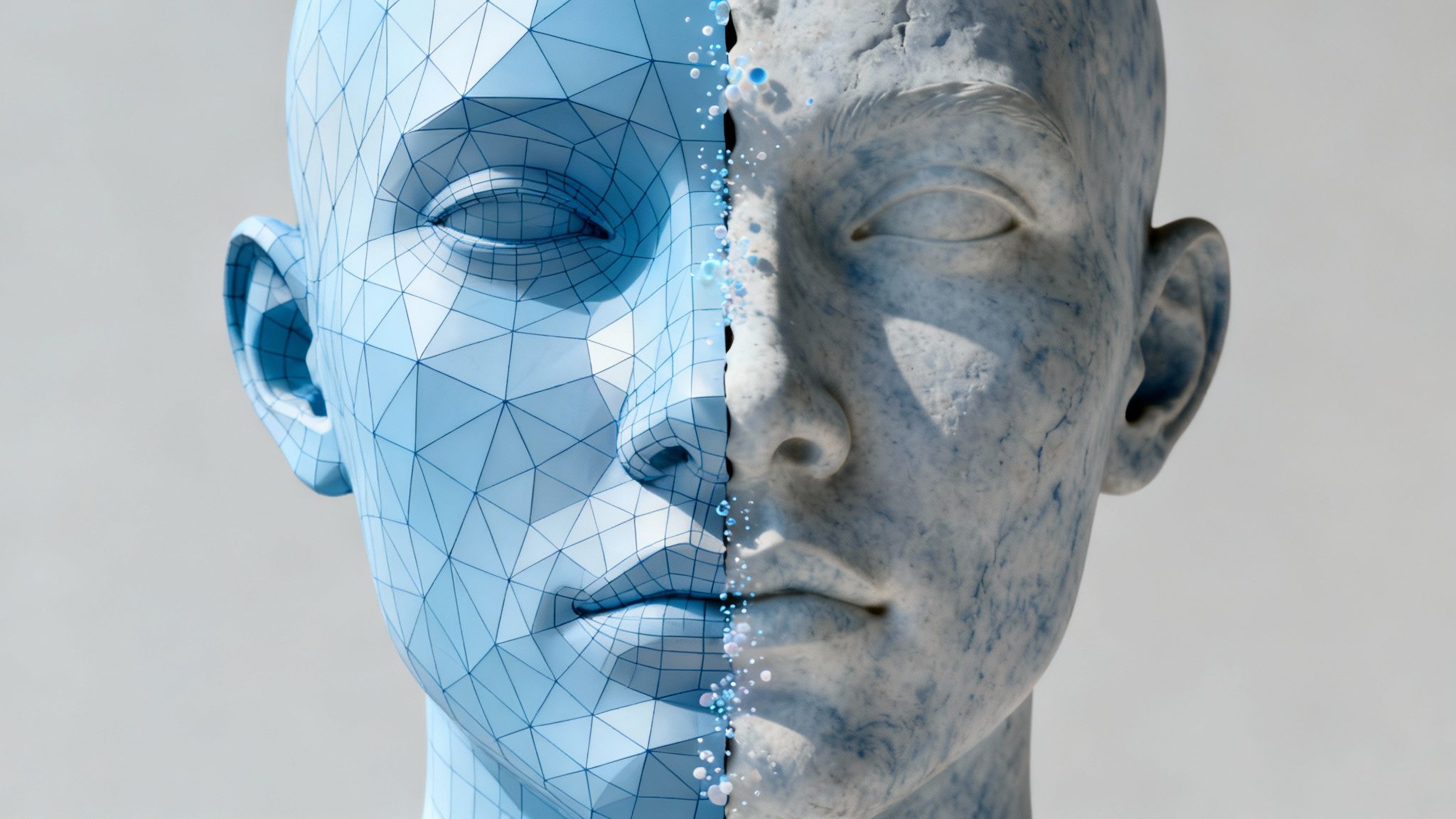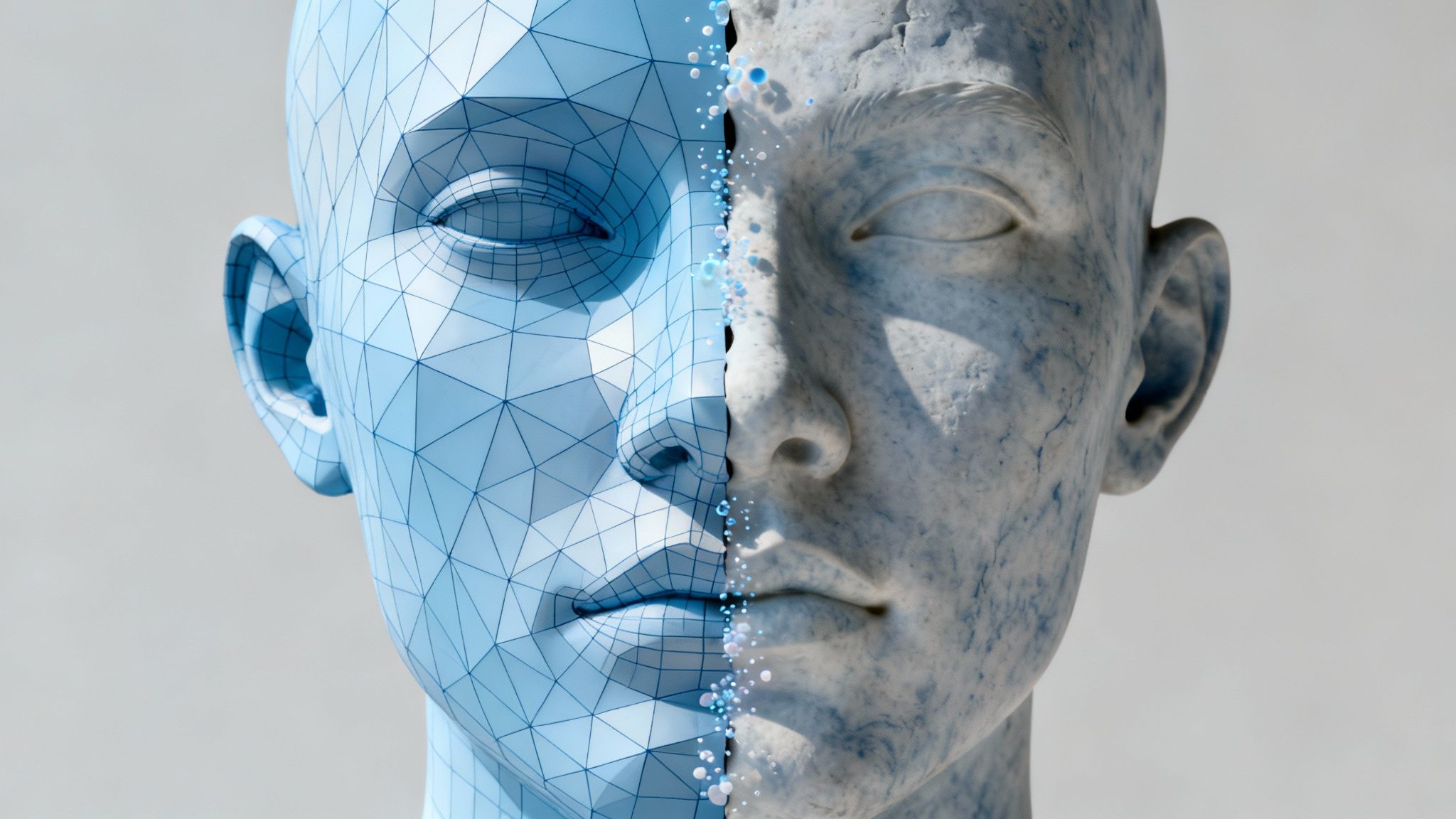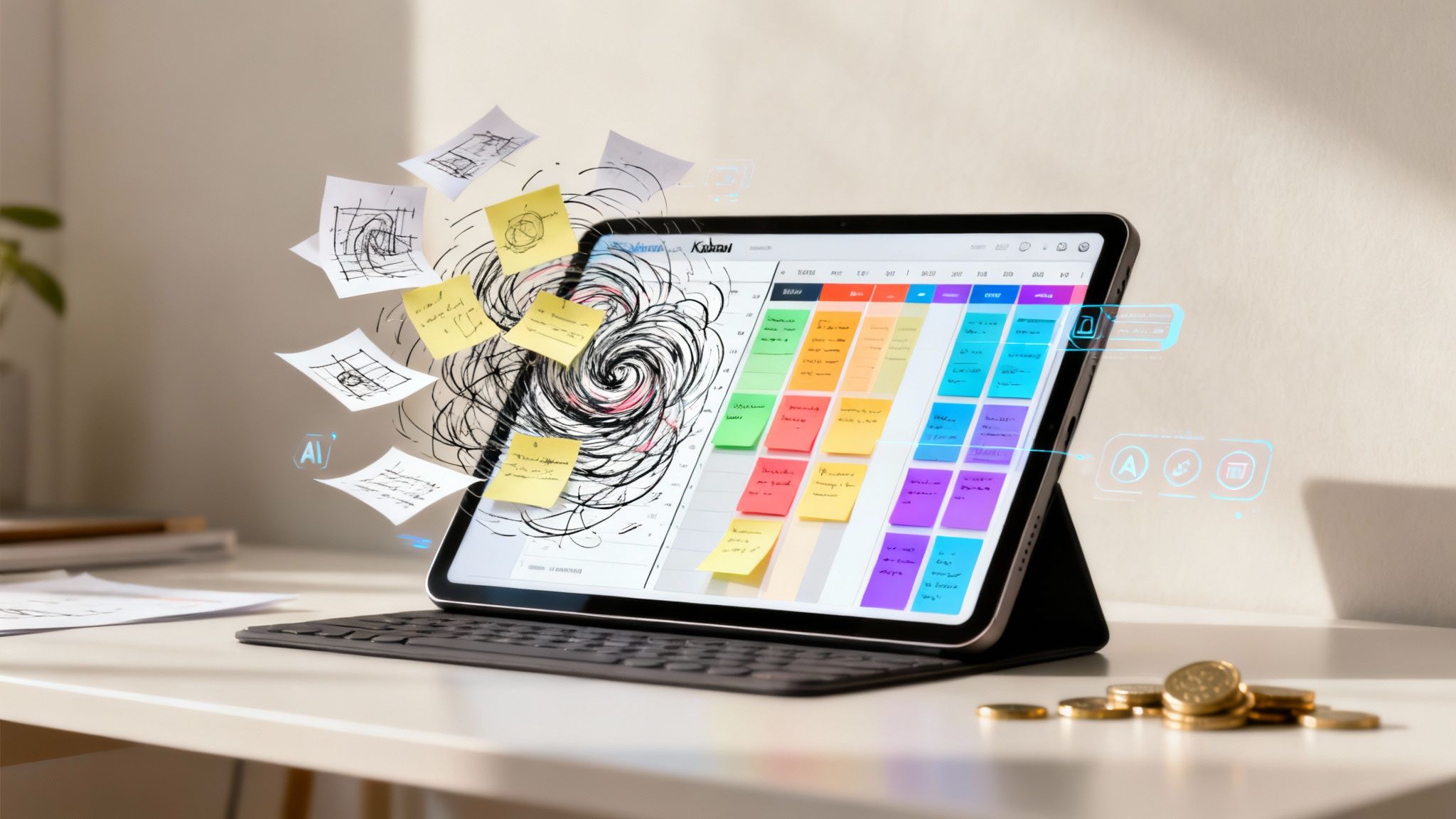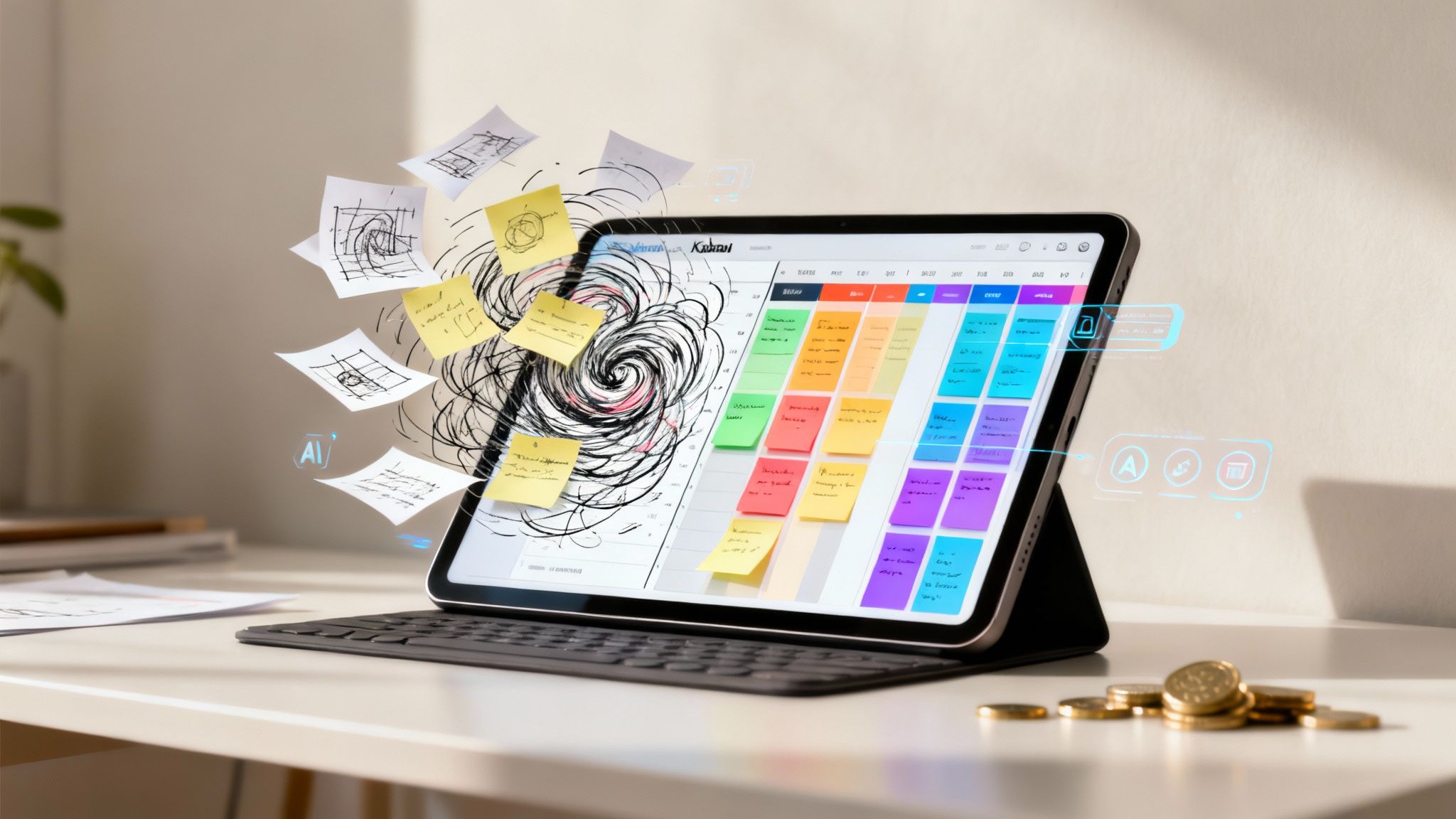If you want to boost your visual creative team's productivity, you need to build on three core pillars: optimized workflows, responsible AI integration, and a culture of genuine engagement.
When these three work together, they cut through the digital noise and let your team focus on impact, not just activity. It's the only way to unlock their full creative potential within a secure and compliant framework.
Defining Productivity for Modern Creative Teams
Let's get one thing straight: tracking hours or counting heads in the office is a dead end for creative teams. True productivity isn't about being busy; it's about the quality, security, and impact of what you create.
Creative work needs deep focus, easy collaboration, and the right tools. When those are missing, your team drowns in administrative tasks, endless revision cycles, and fragmented communication chains—creating risk and inefficiency.
The old-school ways of measuring work just don't fit a process that runs on inspiration and complex problem-solving. We need to shift our thinking. Instead of asking, "How long did that take?" we should be asking, "Did this asset achieve its goal safely and efficiently?" That's the mindset that moves a team from churning out work to delivering real results.
The Real Barriers to Creative Output
The modern workplace has taught us that where and when people work matters less than how they work. While the average workday has actually gotten shorter, productivity is up slightly. The real enemy? Interruptions.
It's reported that an employee gets interrupted every three minutes on average. Worse, it can take over 23 minutes to get back into a state of deep focus after each one. You can read more about the latest workplace statistics to see just how big this problem is.
This constant context-switching is poison for creativity. The bottleneck isn't a lack of effort—it's a lack of protected time and secure, simple processes.
Productivity for a creative team isn’t about producing more in less time; it's about creating the ideal conditions for innovation to flourish. It means removing friction so designers, artists, and developers can spend their energy solving creative challenges, not fighting their tools and compliance requirements.
Three Pillars for Maximum Creative Impact
To really figure out how to improve team productivity, you have to tackle the unique challenges creative work presents head-on. That means building a foundation on three interconnected pillars.
This visual shows how structured workflows, boosted by smart AI and a strong team culture, shield your team from distractions and help them deliver incredible work.
This model lays out a clear path from operational excellence to cultural strength. It’s a blueprint for making productivity gains that are not only substantial but also sustainable and compliant.
To break it down, these three pillars are designed to solve the biggest headaches creative teams face every day. From messy feedback loops to burnout, a structured approach is the only way forward.
Three Pillars of Modern Creative Team Productivity
By building on this foundation, you're not just making your team faster—you're making them more resilient, innovative, and impactful.
Optimizing Your Visual Creative Workflow

A messy workflow is the silent killer of creative momentum. When your team spends more time digging for assets and decoding feedback than actually creating, you're losing the battle before it starts. The solution is to map, secure, and centralize the entire process—from the initial brief all the way to final delivery.
Picture this: you’re trying to coordinate feedback on a new 3D model from five different stakeholders. Without a system, you’re drowning in conflicting emails, Slack messages, and random comments. A structured, compliant system prevents these bottlenecks and ensures everyone is working from the latest version.
This isn’t just about being tidy. It’s the core of improving team productivity. When the process is clear and predictable, your team can pour their energy into brilliant creative work, not administrative chaos.
Establish a Single Source of Truth
First thing’s first: you need a single source of truth. This is one central, secure hub where every project asset, brief, piece of feedback, and conversation lives. No exceptions.
Think of it as the project’s digital HQ. Instead of files scattered across local drives, Google Drive, and forgotten email threads, everything is in one secure place. This one change can save your creatives hours of mind-numbing search time every week.
A unified workspace like Virtuall guarantees that every single person—from the art director to the marketing manager—sees the exact same information. Version control nightmares vanish, and you slash the risk of someone working off an outdated brief, which is a classic recipe for expensive rework.
Define Clear Feedback and Approval Loops
Vague feedback is poison to a creative project. Comments like "make it pop more" or "it just needs a little something" are the reason revision cycles drag on forever. For an efficient workflow, a structured feedback process is non-negotiable.
You need a system where feedback is specific, actionable, and tied directly to the asset. Instead of another vague email, use tools that let stakeholders drop annotated comments right onto an image or 3D model.
Here’s how to put that into practice:
- Standardized brief templates: Ensure every project kicks off with crystal-clear goals, deliverables, and success metrics.
- Set review milestones: Build specific check-in points into your timeline for stakeholder reviews. Don't leave it to chance.
- Consolidated feedback: Appoint one person to gather everyone's notes and consolidate them before they hit the creative team.
A well-defined workflow doesn't restrict creativity; it liberates it. By automating routine tasks and creating clear communication channels, you give your team the structure they need to innovate safely and consistently.
Automate the Administrative Burden
So many tasks that bog down creative teams are purely administrative. Think notifications, file organization, or status updates. Automating these is one of the biggest productivity gains you can implement.
For example, a simple Kanban board that automatically shifts a task to the "In Review" column when a new version is uploaded saves clicks and mental energy. It also makes the project status obvious to everyone at a glance.
Diving into strategies for better creative team project management will give you even more ideas. By chipping away at these small but cumulative burdens, you free your team up to stay in a creative flow state for longer.
Using AI to Safely Augment Creative Output
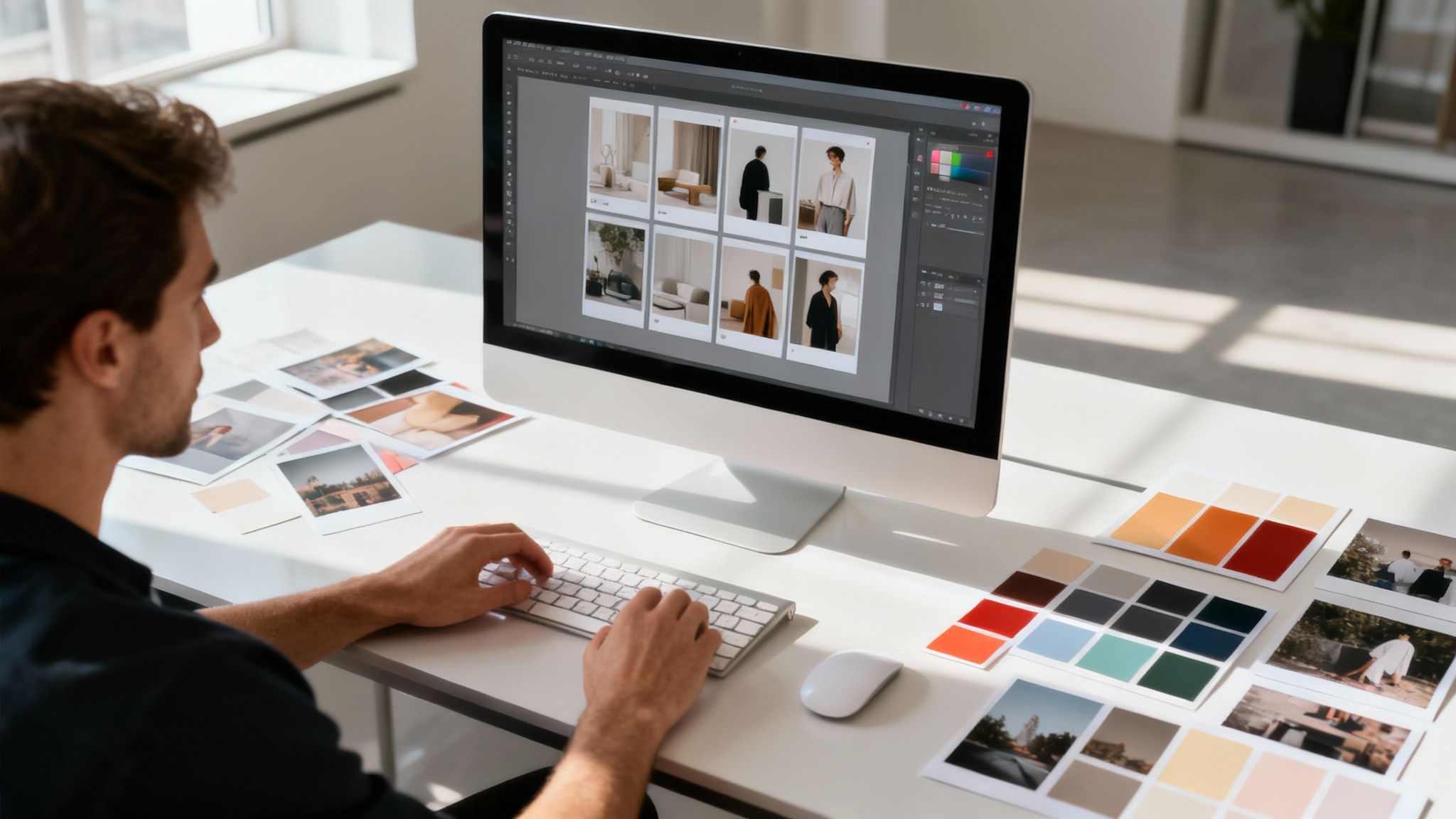
AI is no longer some far-off concept—it’s a practical tool that can become your creative team’s most powerful partner. When integrated responsibly, AI acts as an accelerator. It automates routine work that drains energy, freeing your team to focus on strategic, high-impact tasks.
This isn't about replacing human talent. It's about augmenting it within a secure, enterprise-ready framework that prioritizes compliance and data safety.
Imagine your designers no longer bogged down by tedious asset tagging or manually editing hundreds of images. With AI, those processes get automated, giving them back hours to innovate and solve tough creative problems. The goal is to make AI a supportive collaborator that improves both output and morale.
Automating Repetitive Tasks to Boost Focus
One of the quickest wins with AI is handing off the repetitive, low-value tasks. These are the necessary but uninspiring jobs that often lead to creative fatigue and, eventually, burnout.
Think about the time spent generating initial mood boards or creating dozens of minor variations for a marketing campaign. AI can produce a huge range of visual ideas in minutes, giving your team a solid foundation to build on. This lets creatives jump straight to refining ideas and thinking strategically.
By handling the groundwork, AI gives your team the mental space needed for deep creative thought. It shifts their focus from manual execution to strategic innovation, which is where their true value lies.
This automation also applies to organizational work. For instance, intelligent asset tagging can automatically categorize and keyword your entire library of visual assets. This makes finding the right file a breeze and ensures your creative library remains a useful, searchable resource—not a digital junk drawer.
Enhancing Creativity Without Sacrificing Control
There's a common fear that AI might kill originality, but a well-designed, secure system does the opposite. It acts as a creative co-pilot, helping designers explore possibilities they might not have considered otherwise. A secure platform ensures this exploration happens within a compliant and controlled environment.
Here are a few specific, safe ways to use it:
- Concept Generation: Quickly create multiple visual directions for a new product launch, giving stakeholders a tangible starting point for discussion.
- Batch Image Edits: Apply consistent edits, like resizing or color correction, to hundreds of images at once, ensuring brand consistency with minimal effort.
- 3D Prototyping: Generate initial 3D models from text prompts or 2D images, drastically cutting down the time it takes to visualize a new concept.
The move to AI is already paying off for early adopters. Companies using AI report high productivity levels (72%) and improved job satisfaction (59%). These benefits pop up when AI is integrated thoughtfully, not just dropped into an existing workflow. For more on these findings, you can explore the full report on employee productivity statistics.
Choosing the Right AI Tools for Your Team
Getting AI integration right means picking tools that fit naturally into your team's process. The key is to find platforms built for enterprise security and collaboration, not just standalone consumer apps. To get a better sense of what's out there, check out a guide on AI tools specifically for designers.
A platform like Virtuall brings multiple AI models into a single, secure workspace. This gives your team the power to generate images, 3D models, and video without ever compromising on security or workflow integrity. This approach ensures that while your team is pushing creative boundaries, all assets stay centralized, versioned, and compliant.
Building a Culture of Engagement and Collaboration
You can have the slickest workflows and the smartest AI tools, but they’ll fall flat without an engaged, collaborative team. The human element is what turns a good process into incredible results.
Building a culture where creatives feel motivated, supported, and psychologically safe isn't a "soft skill"—it’s a core business strategy that directly impacts your bottom line.
This means creating an environment where people feel free to share bold, unconventional ideas. It’s about letting a junior designer challenge a lead’s concept without fear. When creatives feel heard and connected to a bigger purpose, they don't just complete tasks; they own outcomes.
The Manager’s Role in Fostering Psychological Safety
A manager’s influence on team culture is massive. They are the architects of the team's daily experience. A critical part of that job is building psychological safety—a shared belief that it's safe to take risks.
For a creative team, this is everything.
It's the freedom to pitch a bold idea that might not work. It’s the confidence to admit you don't have the answer. Without this safety net, innovation grinds to a halt. People play it safe, and you get predictable work instead of groundbreaking solutions.
Managers can build this foundation by:
- Encouraging open dialogue: Don't just ask for feedback; actively pull different opinions into the conversation during reviews and brainstorms.
- Modeling vulnerability: Admit when you’re wrong or unsure. Frame mistakes as learning opportunities, not failures.
- Responding productively: When someone raises a tough issue or makes an error, thank them for their honesty. Focus on the solution, not the blame.
Recognize Great Work and Connect It to Purpose
Consistent recognition is one of the easiest wins for engagement. It shows your team that their hard work is actually seen and valued. This doesn't require a trophy or a bonus. Specific, timely praise for a clever solution or a beautifully executed asset can be incredibly powerful.
But praise alone isn't enough. You have to connect the daily grind to the bigger picture.
A 3D artist isn’t just modeling a prop; they’re building a world that will captivate players. A graphic designer isn't just making a banner ad; they’re creating a brand's first impression. Helping your team see that connection fuels a motivation that no project management tool can replicate.
A highly engaged team isn't a happy accident; it's the direct result of intentional leadership. When managers prioritize clear communication, consistent recognition, and a safe environment for feedback, productivity naturally follows.
Ultimately, a huge part of your team's success comes down to actively building culture at work. The numbers back this up. Teams with high engagement see up to 21% higher profitability, and high-performing teams show 18% greater sales productivity.
And the most telling stat? About 70% of the variance in team engagement is directly tied to the manager. That’s how much of a difference good leadership makes.
Actionable Productivity Tactics for Creative Teams

This is where the rubber meets the road. Moving from high-level strategy to daily habits is how you unlock real gains in creative output. Your team can start using proven tactics today to manage their time, energy, and focus far more effectively.
It's not about working harder; it’s about working smarter on the tasks that actually move the needle.
Small tweaks—like how you structure work sessions or run meetings—can have a massive ripple effect. The goal is to build simple, repeatable systems that eliminate friction and fiercely protect your team’s most precious resource: their creative headspace.
Embrace Time-Blocking and Deep Work
Context-switching is the enemy of great creative work. The best way to fight it is by scheduling dedicated "deep work" blocks—uninterrupted stretches of time for a single, demanding task.
That means zero meetings, notifications off, and a clear signal to everyone else that this time is sacred.
A fantastic method for this is the Pomodoro Technique. It's a simple cycle for staying sharp:
- Pick one task: Focus on a single creative challenge, like storyboarding a cinematic or refining a character model.
- Work for 25 minutes: Set a timer and go. No distractions.
- Take a 5-minute break: Get up, walk around, reset your brain.
- Repeat the cycle: After four Pomodoros, take a longer 15-30 minute break.
This rhythm prevents burnout and keeps energy levels steady, which is a lifesaver for detailed visual work.
Perfect the Creative Brief
Vague instructions are a recipe for disaster. An airtight creative brief is your best defense against endless revision cycles and wasted hours. A solid brief gets everyone—from designers to stakeholders—on the same page from the jump.
Your template needs to eliminate guesswork. Clearly define the project's scope, target audience, key message, and technical specs. Don't forget visual references and a clear definition of what "done" looks like. Getting this right upfront can literally shave weeks off a project timeline.
An airtight brief doesn't just kick off a project; it guides it. It’s a living document that serves as the single source of truth, ensuring every creative decision aligns with the original strategic intent.
A well-organized asset library is just as critical. When your team can instantly find brand guidelines, logos, and approved imagery, they can execute much faster. We dive deeper into this in our guide on how to organize digital assets.
And remember, beyond just optimizing the workflow, you have to keep the team fired up. When you combine a great process with genuine motivation, you see incredible results. It's worth exploring proven strategies to motivate employees to keep engagement and ownership high on every project.
Frequently Asked Questions
Boosting your team's creative output always brings up a few practical questions. It’s never a one-size-fits-all solution, so it's smart to think about how these strategies fit your specific challenges, especially when you're working with visual content.
Here are a few common hurdles teams run into—and how to clear them.
How Do You Measure Creative Productivity Without Micromanaging?
Measuring creative work isn't about counting hours. It’s about impact. Micromanaging kills creativity, so forget about activity logs and focus on metrics that actually reflect momentum.
This approach gives your team the freedom to do their best work while keeping everyone pointed in the same direction.
Look at numbers that tell a story about your workflow's health:
- Project Velocity: How many projects or key tasks is the team completing per week or sprint? This gives you a clean, high-level look at your team's rhythm and capacity.
- Revision Cycles: A high number of revisions is a classic sign of a broken brief or fuzzy communication. Your goal should be to bring the average number of back-and-forths down.
- Asset Reuse Rate: This is a fantastic indicator of efficiency. If your team can quickly find and repurpose existing assets, your system is working. It saves massive amounts of time.
Focusing here helps you measure the effectiveness of your process, not the keystrokes of your people.
How Can Teams Maintain Focus in a Hybrid Environment?
In a hybrid setup, focus doesn't happen by accident. You have to design it. Without the clear boundaries of an office, distractions from home and work can easily bleed into each other.
The trick is to build intentional "focus zones" into the team's calendar. Block out specific times for heads-down, uninterrupted creative work. During these blocks, notifications are off. Meetings are banned.
The goal is to build a culture where everyone respects each other's need for deep work. This isn't about individual discipline—it's a team commitment to protecting creative energy, whether someone is in the office or at their kitchen table.
What Is the Best Way to Get Team Buy-In for New Tools and Processes?
Getting your team excited about a new tool starts by answering one simple question: "What's in it for me?" Creatives are rightfully skeptical of changes that feel like more administrative work for little payoff.
Don't just hand them a new tool; involve them from the start.
Run a small pilot with a few enthusiastic team members. Let them work out the kinks and give you honest feedback. Their success stories will be your most powerful marketing material for everyone else.
And when you introduce the change, frame it around the problems they already have. For instance, instead of just announcing a new AI tool, say, "This will eliminate the hours we waste on tedious background removals, so you can spend more time actually designing."
When they see how it solves a real-world headache, they’ll get on board much faster.
Ready to bring your creative workflow together and see what your team can really do? Virtuall gives you a single, secure workspace for AI-powered asset generation, management, and collaboration. Get from concept to final asset faster than ever.


